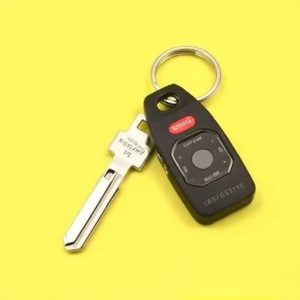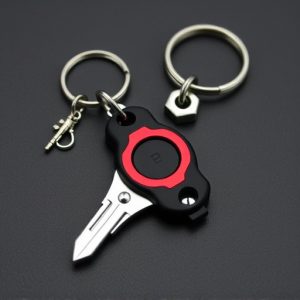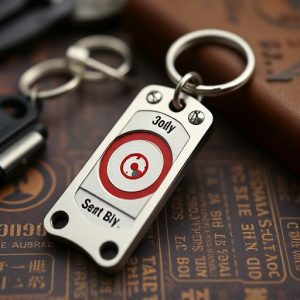Concealed Defense Keychain: Legalities, Choice, & Safe Carry Tips
Before integrating a keychain weapon into your everyday carry (EDC) routine, research local laws and…….
Before integrating a keychain weapon into your everyday carry (EDC) routine, research local laws and obtain necessary permits, as requirements vary. Choose a model with sharp, durable edge, minimal size/weight, impact-resistant materials, and easy deployment. Prioritize safety by staying informed about regulations, maintaining sharpness, complying with permit rules, and undergoing regular training for responsible use in public spaces.
“Unleash your personal safety with the ultimate everyday carry tool—the concealed defense keychain. This compact self-defense device is more than just a key holder; it’s a life-saving option for those seeking peace of mind. In this comprehensive guide, we’ll explore the legalities and permit requirements for keychain weapons, helping you understand what’s allowed. We’ll then dive into choosing the right model with essential features and provide practical tips for everyday carry. Additionally, discover safety measures and training resources to ensure responsible handling. Get ready to empower yourself while navigating the world with confidence.”
- Understanding Keychain Weapon Legalities and Permits
- Choosing the Right Self-Defense Keychain: Features to Consider
- Everyday Carry Tips for Effective Use of a Keychain Weapon
- Safety Measures and Training: Responsibly Carrying a Concealed Defense Keychain
Understanding Keychain Weapon Legalities and Permits
Before considering a keychain weapon as part of your everyday carry (EDC) routine, it’s crucial to understand the legalities and permit requirements surrounding these tools. The legality of carrying a keychain weapon varies significantly from one jurisdiction to another. Some states or regions allow concealed carrying with minimal restrictions, while others have stringent rules or outright prohibit it.
Keychain weapon permit requirements often include background checks, age restrictions (typically 21 or older), and training or certification courses. It’s essential to research your local laws and consult relevant authorities to ensure compliance. Understanding these regulations is the first step in making informed decisions about incorporating a keychain weapon into your EDC kit.
Choosing the Right Self-Defense Keychain: Features to Consider
When selecting a self-defense keychain, it’s crucial to consider several features that will ensure its effectiveness and practicality as an everyday carry tool. Firstly, look for a keychain with a sharp, durable edge designed for cutting or prying—a critical aspect in close-quarters defense scenarios. The size and weight should be minimal, allowing for easy carrying without adding significant bulk to your keys or pockets. Additionally, consider materials that offer impact resistance and longevity; high-quality stainless steel is a popular choice due to its strength and corrosion resistance.
Another important factor is the ease of deployment. Opt for a keychain with a reliable mechanism that allows for swift access in stressful situations. Some models feature automatic opening systems or quick-release levers, making it a seamless addition to your self-defense arsenal without requiring complex manipulation. Remember, the right keychain should complement your everyday carry routine, ensuring you’re prepared and confident while meeting any legal requirements for carrying a keychain weapon, such as permit regulations.
Everyday Carry Tips for Effective Use of a Keychain Weapon
Carrying a keychain weapon can be an effective everyday carry (EDC) choice, but it requires thoughtful consideration and responsible use. To make the most of your compact defense tool, ensure it’s easily accessible yet discreetly hidden. Look for a high-quality keychain with a solid build that won’t break easily or attract unwanted attention. Consider factors like weight, size, and ease of deployment when choosing the right model for you. Remember, a keychain weapon is meant to be a last resort, so keep it sharp, maintain its edge, and familiarize yourself with any local keychain weapon permit requirements. Regular training in proper usage will ensure you’re prepared if needed, enhancing your safety and peace of mind while maintaining a low profile.
Safety Measures and Training: Responsibly Carrying a Concealed Defense Keychain
When carrying a concealed defense keychain, safety should always be the top priority. Before considering this as your everyday carry tool, familiarize yourself with local laws and obtain the necessary permits, if required. The keychain weapon permit requirements vary by jurisdiction, so stay informed to ensure compliance. Responsible ownership includes understanding the legal implications of open or concealed carry in public spaces.
Training is an integral part of safe handling. Practice drawing and deploying your keychain efficiently and safely. Ensure you can operate it quickly without causing harm to yourself or others. Regular drills will help maintain proficiency, making you ready for any unexpected situations. Remember, proper training goes hand in hand with responsible carry, ensuring a secure and effective self-defense mechanism.
When equipped with the right knowledge, understanding the legalities behind keychain weapons, and practicing safety measures, you can effectively incorporate a concealed defense keychain into your everyday carry routine. Remember, while these tools offer an added layer of personal security, responsible ownership and training are paramount. Always stay informed about local laws regarding keychain weapon permit requirements and never hesitate to seek professional instruction to ensure safe and effective use.


